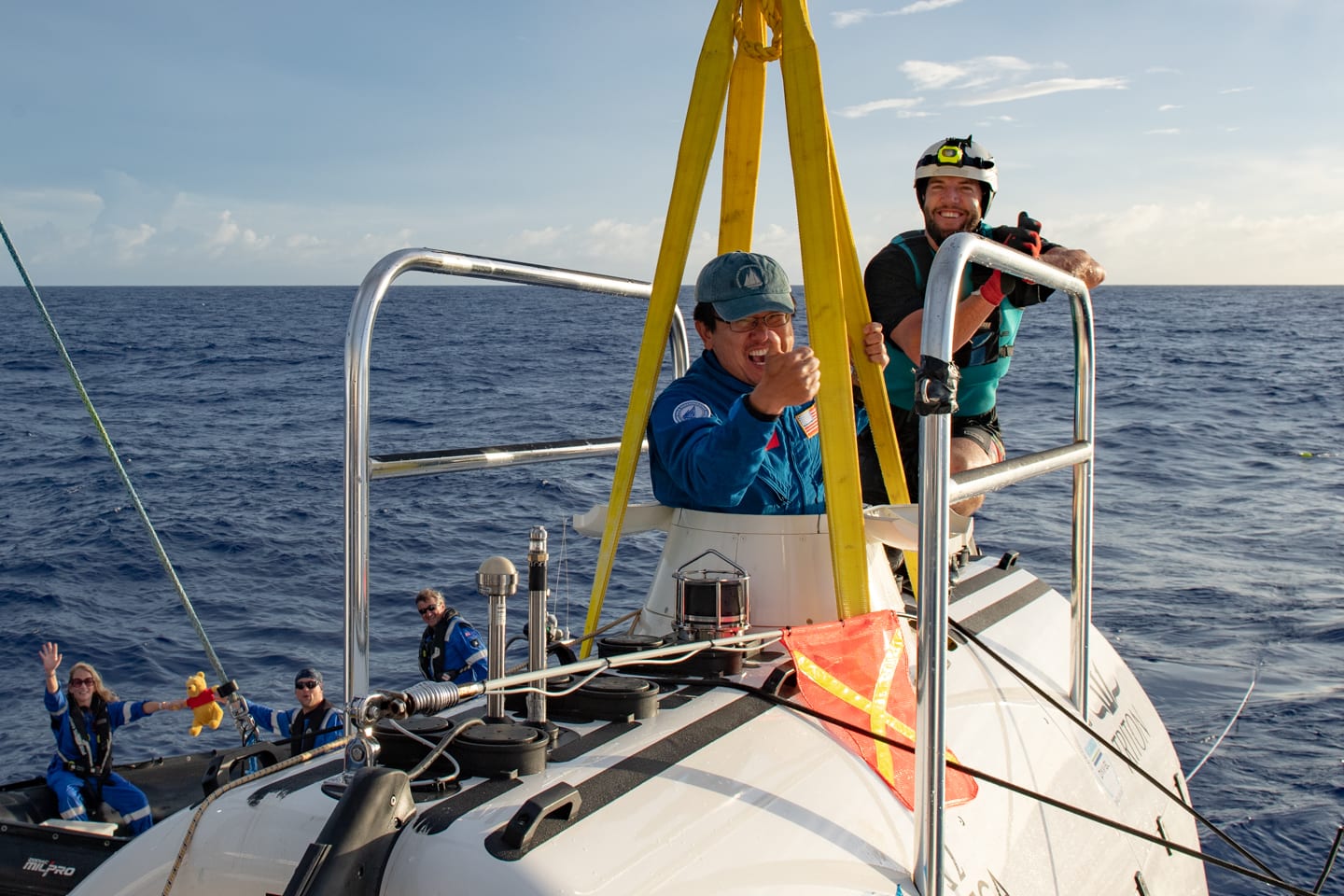Ying-Tsong “Y.T.” Lin, a scientist with WHOI’s Ocean Acoustics & Signals Lab, traveled to the central pool of Challenger Deep in the Mariana Trench, a depth of 10.9 kilometers (6.8 miles), with Victor Vescovo, the pilot and founder of Caladan Oceanic. As a Taiwanese-American, Dr. Lin’s dive marked the first time a person of Asian descent had traveled to the bottom of the Mariana Trench. This record-setting dive was among a series of history-making expeditions that Vescovo piloted this month, including dives by the first woman, former astronaut Kathy Sullivan, and by Kelly Walsh, the son of Don Walsh, who, with Jacques Piccard, made the first-ever dive to the Mariana Trench in 1960.
“The sub Limiting Factor is a space-time capsule bringing us to another world, which has not been touched for millions years,” Dr. Lin wrote in an email from the ship following his 10-hour dive. “Looking at the sand waves on the bottom of the world, thinking how long it took for the weak currents at that depth to build them up, space and time just collapsed; I was watching a million years of evolution in just an instant. What I saw down there makes me feel how insignificant I am. I would like to share this opportunity to understand life better with all my friends and colleagues who helped make it possible.”
As part of Caladan Oceanic’s multidisciplinary Ring of Fire expedition, Dr. Lin is conducting an acoustic experiment aboard the submersible’s support ship, Pressure Drop, to determine how sound waves propagate in the deepest parts of the ocean. Because of the pressure at extreme depths, the increased density of water causes changes in the speed of sound, which need to be carefully accounted for to ensure the accuracy of deep-water acoustic instruments.
With a specialized hydrophone recorder provided by the NOAA Pacific Marine Environmental Laboratory deployed in Challenger Deep, Dr. Lin successfully recorded ambient sound as well as acoustic signals transmitted from an underwater speaker deployed near the ocean surface from the ship. In addition to improving scientists’ understanding of how sound refracts in the deep ocean, Dr. Lin’s shipboard experiments will provide greater clarity on how acoustic communication and geo-location could be improved at extreme depths.
“We are so pleased to have partnered with Y.-T. and Woods Hole Oceanographic Institution on this dive and showing the access we can provide to any individual who wants to regularly and reliably visit any point on the ocean floor,” said Vescovo after the dive.
Dr. Lin is the first WHOI scientist to visit Challenger Deep in-person, but the institution has a history of conducting research at the ocean’s greatest depths. In 2009, WHOI scientists and engineers sent the hybrid remotely operated vehicle Nereus to Challenger Deep, making it just the third vehicle in history to reach a depth of over 10,900 meters. In addition, following James Cameron’s solo dive to Challenger Deep in 2012, the Canadian explorer and director donated his submersible DeepSea Challenger to WHOI so that engineers could document and redeploy some of the technology he and his team developed. These technologies have been incorporated into the autonomous underwater vehicle Orpheus, currently awaiting deep-sea trials.
At WHOI, Dr. Lin is best known for his work on three-dimensional ocean acoustic technologies that help scientists explore the ocean through sound. He lives in Falmouth, Mass., with his wife and sons.
Key Takeaways
- Ying-Tsong Lin is the 12th person in history, as well as the first Taiwanese-American and the first person of Asian descent to travel to the deepest part of the ocean, the Challenger Deep.
- Lin and pilot Victor Vescovo visited the central pool of the Mariana Trench, at a depth of 10.9 kilometers (6.8 miles) aboard the deep-submergence vehicle Limiting Factor.
- Lin is an acoustic scientist who is studying how sound propagates in the ocean.
- The research conducted during the dive, and in Dr. Lin’s shipboard experiments, will lead to increased understanding of sound refraction in the ocean and how acoustic communication and geo-location may be improved at extreme ocean depths.
Original post https://alertarticles.info


